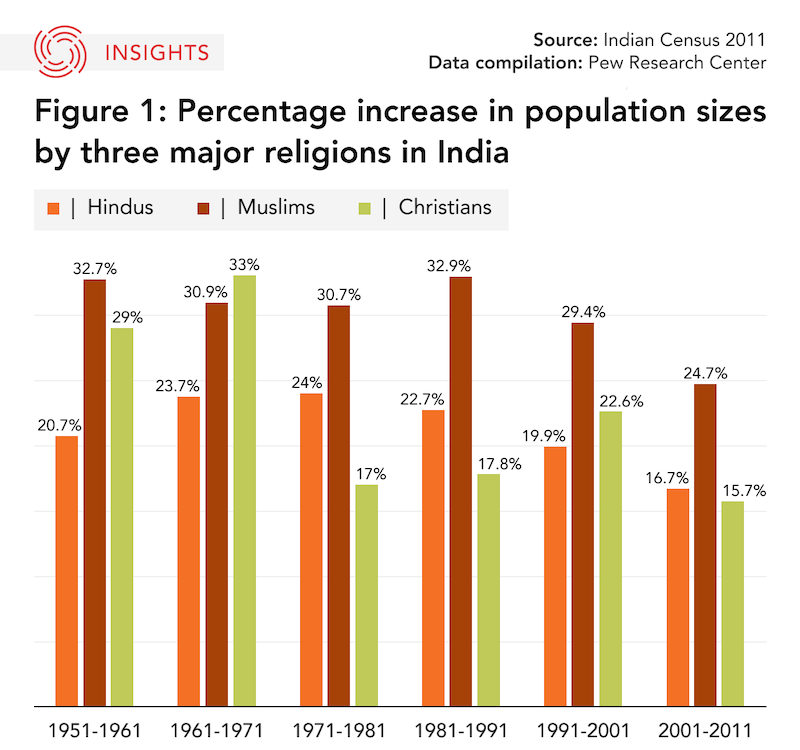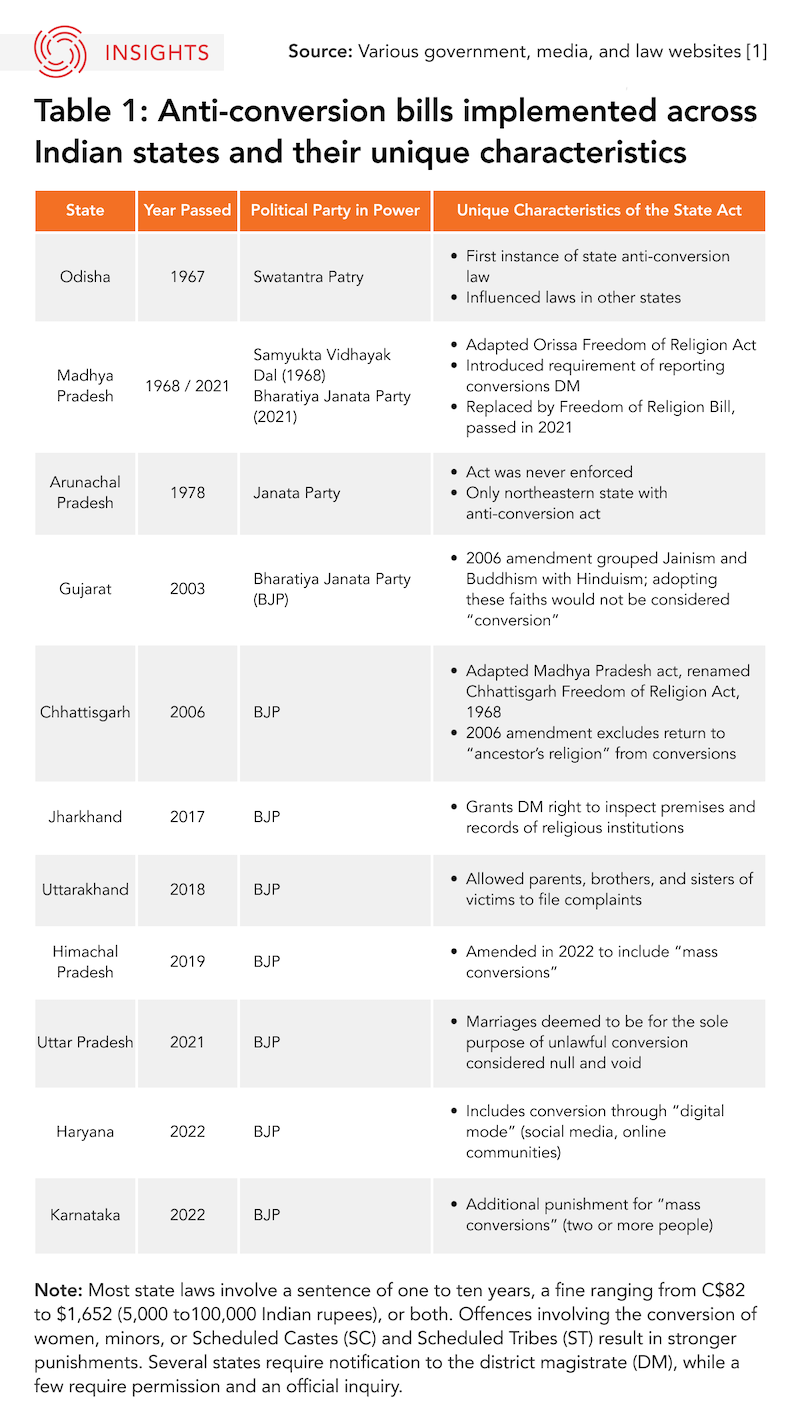The Takeaway
The movement against forced religious conversions – inducing someone to convert from their faith, typically Hinduism, to a religion like Christianity or Islam – has taken another significant turn in India, with a Delhi-based Bharatiya Janata Party (BJP) leader filing a case in the Supreme Court of India seeking directions to regulate the practice of religious conversions. The case comes on the heels of Karnataka becoming the 11th Indian state to pass an anti-conversion bill. The trend of anti-conversion policies has raised questions about the validity of people’s fears of religious conversions and their factual grounding. Are minority communities’ populations growing significantly, and can it be attributed to conversions only, or are there other reasons?
In Brief
In response to a Supreme Court request, the BJP-led central government in India filed an affidavit stating that religious freedom does not include a fundamental “right to convert,” stressing the need to introduce national laws that address forced conversions. The top court’s request follows an ongoing hearing on public interest litigation filed by BJP leader and Supreme Court lawyer Ashwini Kumar Upadhyay, which seeks to implement stringent measures against conversions by coercion or deception. The Supreme Court has observed that they are “not against conversions,” but won't accept forced conversions, which they deem “dangerous” and a threat to national security.
Implications
Religion has a significant role in the Indian Constitution. According to Article 25, “all persons are equally entitled to freedom of conscience and the right freely to profess, practise and propagate religion.” In 1977, the Indian Supreme Court, in its interpretation of this right, gave the verdict that the “right to propagate” refers to a right to transmit or spread one’s religion but not a “right to convert.” It has since served as a benchmark in India, a country where 79.8 per cent of the population identifies as Hindus, 14.2 per cent as Muslims, and 2.3 per cent as Christians.

While the percentage increase of the Muslim population is higher than other groups (Figure 1), according to Pew Research Center, this trend can be attributed to an increase in education of women in Muslim households, which impacts fertility rates, as opposed to religious conversion. A higher educated woman has better job prospects, awareness, and health care, leading to fewer children. In a 2019-20 survey, Pew found that religious conversion in India could be explained by the need for social mobility, especially in a stratified society such as India’s. It also found that religious conversion has little to no impact on the overall religious composition of the Indian community.

Given this context, the introduction of anti-conversion laws by multiple Indian states in the recent past is reflective of the rise of Hindu nationalism in India. The anti-conversion push gained momentum from 1998 to 2004 in particular, when the BJP was in power. Momentum has swelled again since 2014, corresponding to Narendra Modi becoming Indian prime minister. Most states that implemented anti-conversion laws (Table 1) did so under BJP (or coalition) governance and have implemented strict penalties. The need to acquire an official permit for religious conversion raises the question if it is indeed protecting people from forced conversions or impeding one’s right to religion, which should be a private act.
What’s next
-
A tool to intimidate minorities?
Critics claim there is a lack of hard data on the number of court cases filed under the new anti-conversion laws, and how many among them are forced conversions. Observers state that the laws can be used to intimidate religious and caste minorities, particularly as intolerance continues to grow in the country.
-
Love jihad and ghar wapsi (homecoming) campaigns
The promotion of anti-conversion sentiment has influenced the Islamophobic love jihad conspiracy by the Hindu-right, which claims that Muslim men lure Hindu women through kidnapping, deception, and seduction, intending to convert them. Additionally, the contradictory nature of these anti-conversion laws does not consider “re-conversion” to Hinduism as conversion, leading to ghar wapsi, or ‘homecoming’ campaigns, which attempt to bring Christians and Muslims ‘back’ into the Hindu fold. Even Hindu activist groups in the diaspora, such as the Global Hindu Heritage Foundation (GHHF) in the U.S., claimed to convert people 'back to' Hinduism. This points to broader national and diasporic insecurities around supposed threats to India’s status as a Hindu nation, as envisioned by right-wing Hindu nationalists.
• Produced by CAST's South Asia Team: Dr. Sreyoshi Dey (Program Manager); Narayanan (Hari) Gopalan Lakshmi (Analyst); and Prerana Das (Analyst).
Karnataka: https://indianexpress.com/article/political-pulse/anti-conversion-laws-himachal-up-karnataka-comparison-8092477/
Karnataka: https://prsindia.org/files/bills_acts/bills_states/karnataka/2021/Anti%20Conversion%20Bill.pdf
Haryana: https://www.nextias.com/current-affairs/05-03-2022/haryana-prevention-of-unlawful-conversion-of-religion-bill-2022
Uttar Pradesh:https://prsindia.org/files/bills_acts/acts_states/uttar-pradesh/2021/Act%20No%203%20of%202021%20UP.pdf
Jharkhand: http://www.bareactslive.com/JH/jhr304.htm
Gujarat: https://www.livelaw.in/pdf_upload/gujarat-freedom-religion-bill-391340.pdf
Himachal Pradesh: https://www.indiacode.nic.in/bitstream/123456789/5395/1/the_himachal_pradesh_freedom_of_religion_act%2C_2006.pdf
